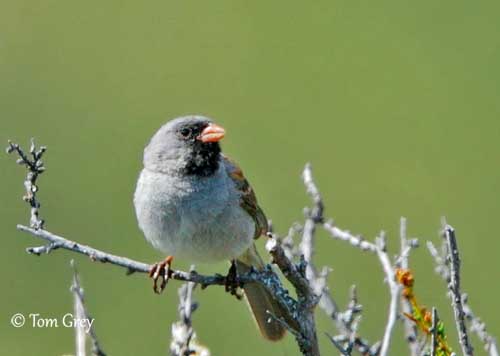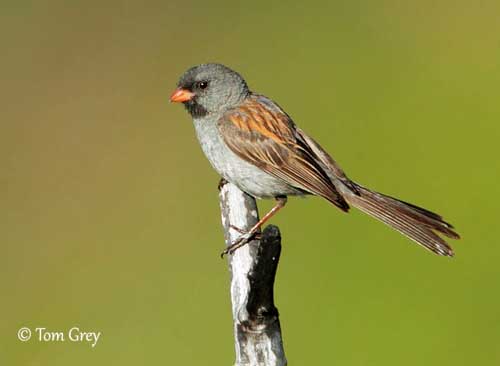
Fr: Bruant à menton noir
All : Schwarzkinnammer
Esp: Chimbito Carbonero
Ital: Passero golanera
Nd: Zwartkingors
Sd: Chaparralsparv
Photographer:
Tom Grey
Tom Grey's Bird Pictures
Text by Nicole Bouglouan
Sources:
HANDBOOK OF THE BIRDS OF THE WORLD Vol 16 by Josep del Hoyo- Andrew Elliot-David Christie – Lynx Edicions – ISBN: 9788496553781
A GUIDE TO THE BIRDS OF MEXICO AND NORTHERN CENTRAL AMERICA by Steve N. G. Howell, Sophie Webb - Oxford University Press - ISBN: 0198540124
FIELD GUIDE TO THE BIRDS OF NORTH AMERICA - National Geographic Society - ISBN: 0792274512
BirdLife International (BirdLife International)
The Cornell Lab of Ornithology – Neotropical birds
All About Birds (Cornell Lab of Ornithology)
SORA Searchable Ornithological Research Archive (Blair O. Wolf)
Black-chinned Sparrow
Spizella apogularis
Passeriforme Order – Passerellidae Family
BIOMETRICS:
Length: 14-15 cm
Weight: 9-15 g
DESCRIPTION:
The Black-chinned Sparrow is a small bird usually difficult to see!
The adult male has cinnamon-brown upperparts streaked black, except rump and uppertail-coverts which are grey or olive-grey. The upperwing is dark brown with pale buff-edged feathers. The lesser coverts are grey. The median coverts show dark brown central area and buffy tips. In breeding plumage, the tips are paler and form a wingbar. Greater coverts and tertials have blackish centre with tawny fringes, and pale buff on tips forming an indistinct second wingbar. The tail is dark greyish-brown.
On the underparts, chin and throat are black, mostly greyer outside the breeding season. Breast and rest of underparts are grey, with pale central belly and undertail-coverts.
Head is grey with black lores, bill base, chin and throat.
The bill is bright pink. The eyes are dark brown. Legs and feet are pinkish.

The female is duller with grey head slightly washed brownish. The black areas are more restricted and greyer.
The juvenile resembles female but it lacks the black areas of the face. On the upperparts, streaks are narrower and scapulars are tawny-brown. The underparts are variably streaked pale grey.
We can find four subspecies:
S.a. evura is paler than nominate and has less black on throat.
This one breeds in SE California, S Nevada, SW Utah, C and SE Arizona, S New Mexico, W Texas and extreme N Mexico. The non-breeding range is unknown.
S.a. cana has shorter tail and is smaller than nominate race and “evura”. It has washed brownish underparts.
It breeds in the inner coastal mountains of C and SW California and extreme NW Mexico. The non-breeding range extends from SW California to S Baja California.
S.a. caurina (here displayed) is darker grey and less brown than other subspecies.
This one breeds in coasts of WC California and occasionally in S Oregon. The non-breeding range is poorly known.
S.a. apogularis (here described) occurs on Centre Plateau of Mexico.
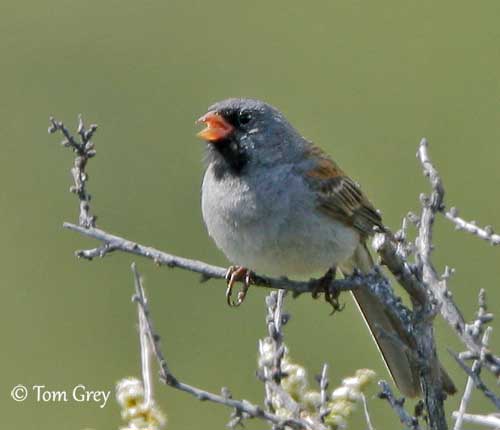
VOICE: SOUNDS BY XENO-CANTO
The Black-chinned Sparrow utters high, thin, fairly sharp “tsik” or “seep”.
The clear song is an ascending or descending trill “sweet sweet sweet te te te te”.
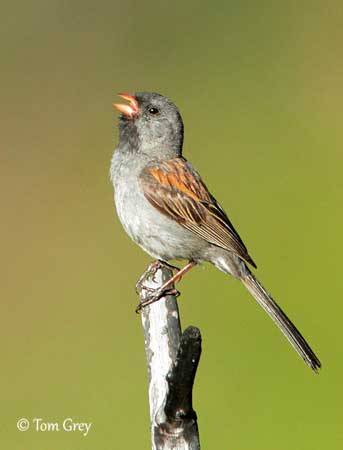
HABITAT:
The Black-chinned Sparrow frequents dry chaparral in foothills and other similar brushy habitats. This species is common in tall, dense sagebrush (Artemisia tridentata) and arid scrublands, often with scattered Yucca. It also frequents open Juniperus woodlands in rocky areas and arid slopes.
This species is visible between 1200 and 2500 metres of elevation, often lower in winter.
RANGE:
See above in “subspecies”.
BEHAVIOUR:
The diet of the Black-chinned Sparrow is poorly known, but during summer from some records, it feeds on larval insects, but probably takes adults too. It gleans them from ground and inner foliage, foraging in several plant species and trees such as Pinus, Juniperus, Rhamnus californica, Ephedra nevadensis and Adenostoma fasciculatum.
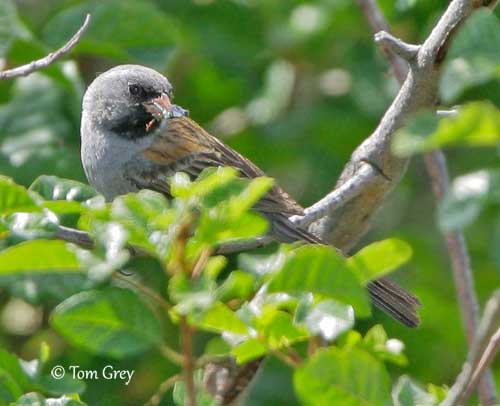
This small bird is usually difficult to find, retiring and inconspicuous, but it often sings from exposed perches. Rarely seen in small groups except sometimes in winter, it usually occurs singly or in pairs.
During the breeding season, the male is territorial. It remains close to the female during the egg-laying, performing a kind of “mate-guarding”. Nest building and incubation are usually by female, but both parents feed the chicks. During the incubation, the male may feed the female at nest.
This species is monogamous. As numerous Emberizidae species, they probably perform elaborate flight displays. If they are threatened at nest-site, adults perform the typical “broken wing” display to lead predators away from the nest.
Some populations and mainly the northern ones, may migrate southwards in winter, but the non-breeding grounds are poorly known. Migrations depend on rainfall patterns.
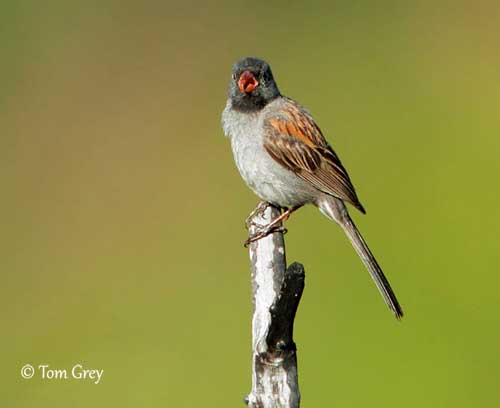
FLIGHT:
The flight of the Black-chinned Sparrow is direct. It flies low from the ground, passing through the bushes or close to the top.
REPRODUCTION:
The breeding season occurs from late April to early July, with peak between mid-May and mid-June.
The Black-chinned Sparrow may be loosely colonial. The nest is built by the female. This is a simple cup made with grasses, yucca fibres, stems, bark, and probably some small twigs and leaves. The inner cup is lined with softer materials.
Such nest is placed towards the middle of a shrub and well concealed, at about 45 cm from the ground.
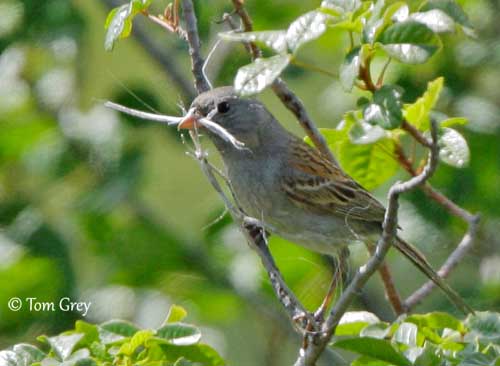
The female lays 3-4 pale greenish eggs with dark scattered spots. She incubates during 10-12 days. The chicks are fed by both parents.
The nest is very occasionally parasitized by the Brown-headed Cowbird.
This species usually produces a single brood, maybe sometimes two or three. If the first clutch is lost, the female lays a replacement clutch.
DIET:
Poorly known. The Black-chinned Sparrow feeds on larval insects, and probably takes adults too during summer. During winter, it consumes seeds from grasses, and may join scattered flocks of other sparrows.
PROTECTION / THREATS / STATUS:
The Black-chinned Sparrow is generally uncommon and local, and may be common in suitable habitat.
This species is threatened by habitat loss due to mining activities, off-road vehicles and overgrazing, the latter mainly in wintering grounds.
However, this species is not currently threatened.
